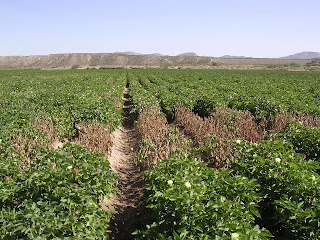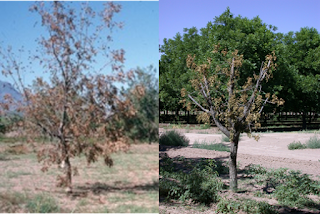 |
Pear tree infected with Phymatotrichopsis omnivora
(these two photos were taken one week apart)
(Photo: NMSU-PDC) |
 |
Characteristic cruciform (cross-shaped) hyphae of
Phymatotrichopsis omnivora (Photo: NMSU-PDC) |
Featured Diagnosis: Phymatotrichum root rot. This disease is also commonly known as Texas root rot or cotton root rot. It is caused by the soil-borne fungus
Phymatotrichopsis omnivora. The fungus has an extremely wide host range that affects more than 2,300 species of dicotyledonous (broad-leafed plants). This disease produces very distinctive symptoms on plants and characteristic fungal structures which make diagnosis relatively easy (assuming the plant specimens evaluate contain the appropriate material). The most noticeable symptom on plants is rapid death of the crown with leaves remaining attached to the plant. Although the plant may have been infected for some time, symptoms appear quickly making it seem as if the plants died in a matter of days! The fungus produces fungal strands on roots which produce characteristic cruciform (cross-shaped) hyphae. Observation of cruciform hyphae under the microscope is a confirmation of the disease. The fungus is VERY LIMITED geographically to parts of the Southwestern United States and Mexico. Even within its geographical boundaries, the fungus is spotty in occurrence. The pathogen may be so isolated that it is only found in small areas; areas small enough that only one or a few plants are affected. It may also be found in larger areas where many plants may be affected. It is found only at elevations below 5,000 feet. In New Mexico, the disease has been found only in the southern part of the state (see map).
If you are concerned that you may have a plant with this disease, please contact your local county extension agent for assistance in submitting specimens for diagnosis.
Read on for more information on pecan diseases
 |
New Mexico Counties were Phymatotrichum
root rot has been confirmed since 1993 |
 |
Spore mat on Phymatotrichopsis omnivora
on the soil (Photo: R. B. Hine,
University of Arizona) |
 |
Phymatotrichum root rot on cotton
(Photo: NMSU-PDC) |
 |
Fungal strands of Phymatotrichopsis omnivora
on a cotton root (left) and a pecan root (right)
(Photos: NMSU-PDC, left; and R. B. Hine,
University of Arizona, right) |
 |
Phymatotrichum root rot on pecan trees
(Photos: NMSU-PDC)
|
 |
Phymatotrichum root rot on a pistachio
tree (Photo: NMSU-PDC) |
 |
Phymatotrichum root rot on Chinese pistache (left); Close up of leaves clinging to the branches (right);
Fungal strand from the roots of this tree (insert). (Photos: NMSU-PDC) |










No comments:
Post a Comment